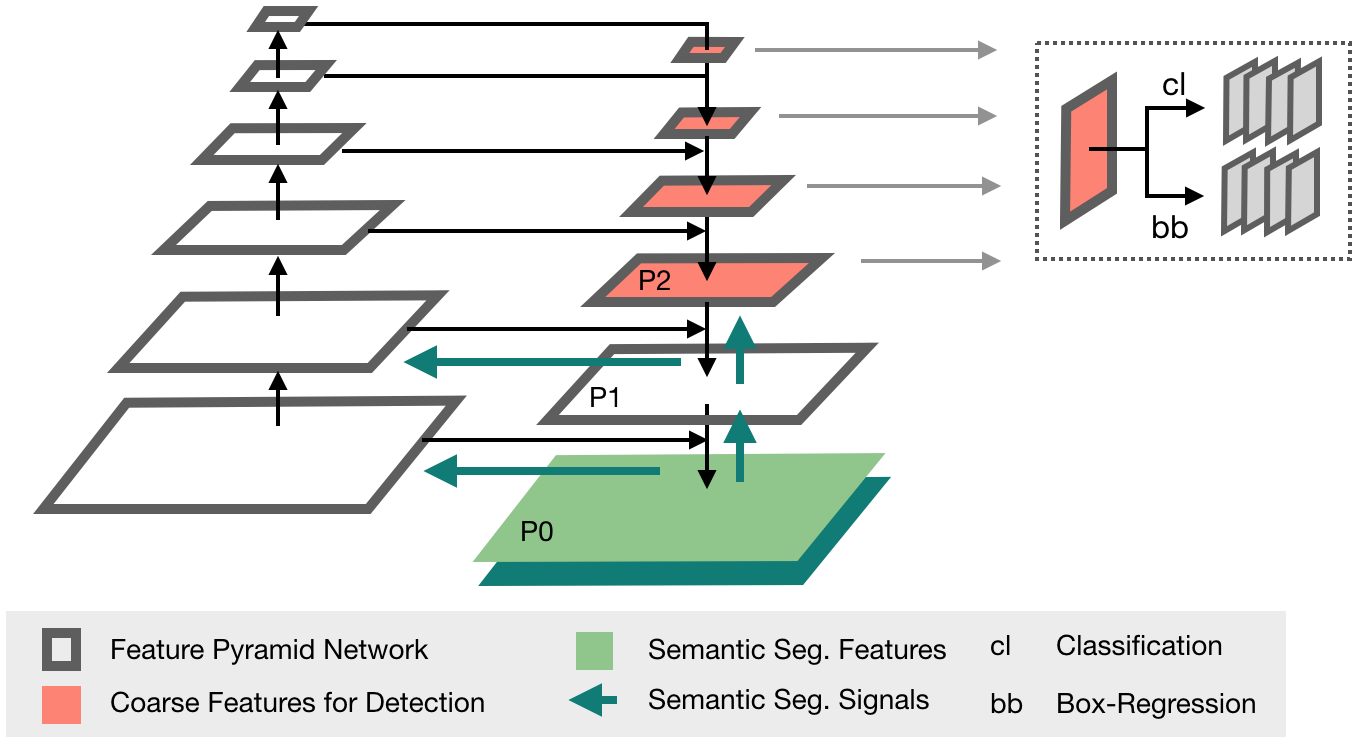THU模式识别2021春 -- Jittor 医学图像分割
模型列表
本仓库收录了课程作业中同学们采用jittor框架实现的如下模型:
- UNet
- SegNet
- DeepLab V2
- DANet
- EANet
- HarDNet及其改动HarDNet_alter
- PSPNet
- OCNet
- OCRNet
- DLinkNet
- AttentionUNet
- UNet++
- UNet+++
- DenseUNet
- TernausNet
- CSNet
- SCSENet
- U2Net
- U2Net-small(轻量化的U2Net)
- Multi-ResUNet
- R2 UNet
- R2 Attention UNet
- LightNet
- OneNet(轻量化的UNet)
- CENet
- LRF-EANet
- SimpleUNet
- SETR
课程同学提出的优秀方案
增加小模型的鲁棒性
成员:汪元标,黄翰,李响,郑勋
-
Spatial Transformer Network(STN)
通过对图片做自适应的仿射变换提高模型的鲁棒性

其中Localization Network采用了多层卷积block的结构,输出通道数分别为8, 16, 32, 64,每个block包括一个3x3的二维卷积,BatchNorm层以及ReLU激活函数,最后经过一个Adaptive Average Pool层实现对多尺寸的支持,参见
advance/stn.py -
对比学习自监督预训练
为了学习CT图像的Latent Feature,采用了对比学习的算法,使用了InfoNCE作为损失函数,采用Memory Bank来采样负例。

-
数据增强
采取了颜色空间的变换,包含亮度、对比度、色相、色调的随机变换。
-
效果
经过改动后的UNet有很好的鲁棒性。即使是智能手机拍摄的照片也可以很好地识别

-
demo
-
参见清华云盘链接
-
用法
> export FLASK_APP='app.py' > python -m flask run -p [PORT]
-
轻量化模型
游嘉诚
为了降低参数量,考虑使用组卷积(group conv),然而组卷积限制了通道之间的信息交流。传统channel shuffle 限制了各 group 信息交流的表达力,同时内存访问连续性差或MACS大。于是提出了领域通道平移(channel shift),即通道顺序平移0.5*group,保证各组只与邻域交流,也许可能使得关系密切的组也许会趋向聚在一起。网络开始使用$4\times4$卷积核和stride=4进行四倍下采样,最终使用转置卷积ConvTranspose进行4倍上采样。类似densenet思想,网络将特征图进行通道拼接后进行转置卷积上采样。
二、数据
腰椎骨松质分割数据集
协和医院和中山医院分别提供了腰椎数据集,经过同学们的标注,从协和数据集中划分出了训练集、验证集和测试集。
协和数据集选择并标注了腰椎3,腰椎4的CT片,其中:
-
训练集:包含85人共计1442张腰椎CT片
-
验证集:包含31人共计549张腰椎CT片
-
测试集:包含36人共计615张腰椎CT片
下图展示了协和数据集的样例
中山数据集被用于测试模型的跨数据集泛化性能,中山数据集包含大图和小图两种类型,选择并标注了腰椎1,腰椎2的CT片。其中:
-
大图:包含134人共计858张腰椎CT片
-
小图:包含134人共计868张腰椎CT片
下图分别是中山数据集的大图和小图样例
胰腺分割数据集
胰腺分割数据集包含
-
训练集:包含8人共计1720张CT片
-
验证集:包含2人共计424张CT片
-
测试集:包含2人共计401张CT片
下载地址
清华云盘 数据下载成功后将压缩包解压为 ./data 文件夹即可。
运行方法
-
配置相应环境,安装Jittor最新版本
-
下载数据集
-
下载一些模型必须的ImageNet预训练权重,并解压至
model/目录下. -
运行训练/测试/可视化
usage: run.py [-h]
[--model {unet,hrnet,setr,unet3p,segnet,hardnet,deeplab,pspnet,danet,eanet,ocrnet,resunet,ocnet,attunet,dense,dlink,ternaus,scseunet,r2,r2att,csnet,unetpp,unetppbig,multires,u2net,u2netp,onenet,lightnet,cenet,setr,hardalter,lrfea,simple}]
[--pretrain] [--checkpoint CHECKPOINT] --dataset
{xh,xh_hard,zs_big,zs_small,pancreas} --mode
{train,test,predict,debug} [--load LOAD] [--aug] [--cuda]
[--stn] [-o {Adam,SGD}] [-e EPOCHS] [-b BATCH_SIZE] [-l LR]
[-c CLASS_NUM] [--loss LOSS] [-w BCE_WEIGHT] [-r RESULT_DIR]
[--poly]
optional arguments:
-h, --help show this help message and exit
--model {unet,hrnet,setr,unet3p,segnet,hardnet,deeplab,pspnet,danet,eanet,ocrnet,resunet,ocnet,attunet,dense,dlink,ternaus,scseunet,r2,r2att,csnet,unetpp,unetppbig,multires,u2net,u2netp,onenet,lightnet,cenet,setr,hardalter,lrfea,simple}
choose the model
--pretrain whether to use pretrained weights
--checkpoint CHECKPOINT
the location of the pretrained weights
--dataset {xh,xh_hard,zs_big,zs_small,pancreas}
choose a dataset
--mode {train,test,predict,debug}
select a mode
--load LOAD the location of the model weights for testing
--aug whether to use color augmentation
--cuda whether to use CUDA acceleration
--stn whether to use spatial transformer network
-o {Adam,SGD}, --optimizer {Adam,SGD}
select an optimizer
-e EPOCHS, --epochs EPOCHS
num of training epochs
-b BATCH_SIZE, --batch-size BATCH_SIZE
batch size for training
-l LR, --learning-rate LR
learning rate
-c CLASS_NUM, --class-num CLASS_NUM
pixel-wise classes
--loss LOSS Choose from 'ce', 'iou', 'dice', 'focal', if CE loss
is selected, you should use a `weight` parameter
-w BCE_WEIGHT use this weight if BCE loss is selected; if w is
given, then the weights for positive and negative
classes will be w and 2.0 - w respectively
-r RESULT_DIR, --resultdir RESULT_DIR
test result output directory
--poly whether to use polynomial learning rate scheduler
- 运行对比学习预训练
usage: run_ssl.py [-h]
[--model {unet,hrnet,setr,unet3p,segnet,hardnet,deeplab,pspnet,danet,eanet,ocrnet,resunet,ocnet,attunet,dense,dlink,ternaus,scseunet,r2,r2att,csnet,unetpp,unetppbig,multires,u2net,u2netp,onenet,lightnet,cenet,setr,hardalter,lrfea,simple}]
--dataset {xh,xh_hard,zs_big,zs_small,pancreas}
[--save SAVE] [-e EPOCHS] [-c CLASS_NUM] [-b BATCH_SIZE]
[--channel EMBEDDING_CHANNEL] [--layer LAYER] [--lr LR]
[--pretrain]
optional arguments:
-h, --help show this help message and exit
--model {unet,hrnet,setr,unet3p,segnet,hardnet,deeplab,pspnet,danet,eanet,ocrnet,resunet,ocnet,attunet,dense,dlink,ternaus,scseunet,r2,r2att,csnet,unetpp,unetppbig,multires,u2net,u2netp,onenet,lightnet,cenet,setr,hardalter,lrfea,simple}
choose a model network
--dataset {xh,xh_hard,zs_big,zs_small,pancreas}
select a dataset
--save SAVE model weights save path
-e EPOCHS, --epochs EPOCHS
number of training epochs
-c CLASS_NUM, --class-num CLASS_NUM
class number
-b BATCH_SIZE, --batch-size BATCH_SIZE
training batch size
--channel EMBEDDING_CHANNEL
number of channels of embedded feature maps
--layer LAYER layer to extract features from
--lr LR learning rate
--pretrain
运行示例 参见train.sh, batch_test.sh, pretrain.sh
四、实验结果
胰腺分割数据集
各模型均采用相同超参数,学习率为3e-4,迭代次数50次,以权重为[0.8, 0.2]的交叉熵损失函数进行训练,参见train.sh中dataset为pancreas的部分。结果如下:
| Model | Dice | mIoU |
|---|---|---|
| UNet | 0.7292 | 0.6477 |
| SegNet | 0.6291 | 0.5726 |
| DeepLab | 0.8306 | 0.7467 |
| DANet | 0.7787 | 0.6928 |
| EANet | 0.6753 | 0.6055 |
| HarDNet | 0.7491 | 0.6654 |
| HarDNet_alter | 0.7779 | 0.6920 |
| PSPNet | 0.7772 | 0.6914 |
| OCNet | 0.7789 | 0.6930 |
| OCRNet | 0.7034 | 0.6272 |
| DLinkNet | 0.4995 | 0.4989 |
| AttentionUNet | 0.7691 | 0.6836 |
| UNet++ | 0.8282 | 0.7439 |
| UNet+++ | 0.7892 | 0.7030 |
| DenseUNet | 0.8053 | 0.7194 |
| TernausNet | 0.6752 | 0.6055 |
| CSNet | 0.4994 | 0.4989 |
| SCSENet | 0.4994 | 0.4989 |
| U2Net | 0.8143 | 0.7289 |
| U2Net-Small | 0.8338 | 0.7502 |
| Multi-ResUnet | 0.7230 | 0.6427 |
| R2UNet | 0.8289 | 0.7447 |
| R2AttentionUNet | 0.8084 | 0.7227 |
| LightNet | 0.8006 | 0.7145 |
| OneNet | 0.7754 | 0.6896 |
| CENet | 0.7583 | 0.6735 |
| LRF-EANet | 0.6942 | 0.6197 |
| SimpleUNet | 0.7395 | 0.6569 |
| SETR | 0.4994 | 0.4989 |
| UNet-SSL | 0.8026 | 0.7165 |
| UNet-STN-SSL | 0.7926 | 0.7063 |
| UNet-Aug-STN-SSL | 0.6938 | 0.6192 |
腰椎骨松质分割数据集
-
协和数据集
下表展示了三种模型使用不同损失函数及加权组合的结果
mIoU CE IoU Dice Focal 0.8CE+0.2IoU 0.5CE+0.5IoU 0.2CE+0.8IoU 0.5CE+0.5Dice UNet 95.49 95.56 95.41 95.43 95.48 95.25 95.42 95.17 HRnet 95.22 95.23 N/A N/A — — — — SETR 87.59 87.81 85.92 83.85 88.34 83.94 87.52 87.78 -
中山数据集
下表记录了协和数据集上训练的OneNet模型在中山数据集上的表现








